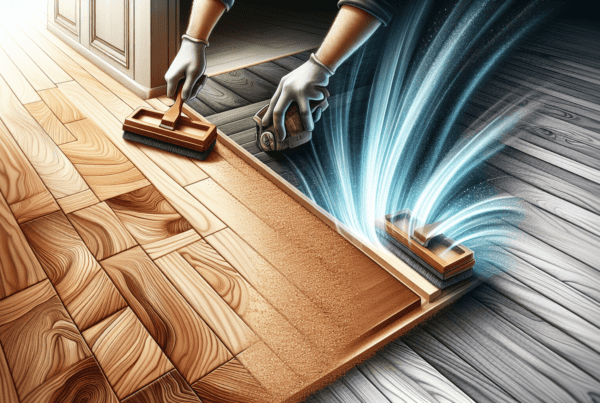In the heart of Wellington, experiencing the transformation of timber floors through custom sanding and finishing is something us locals have grown to admire greatly. With skilled artisans at the helm, each project is a journey from aged or worn to brilliantly restored, breathing new life into homes and spaces. It’s a process that not only revitalizes the flooring but also brings out the unique character and warmth of timber, making each space truly one-of-a-kind. Join us as we explore the craft of custom timber floor sanding and finishing in Wellington, and how it’s redefining the beauty of our interiors.
The Importance of Floor Sanding and Finishing
When it comes to maintaining our timber floors, many of us recognize the need but might not understand the full extent of its importance. Let’s dive into why floor sanding and finishing are crucial steps in preserving the beauty and functionality of our wooden floors.
Extending the Lifespan of Timber Floors
One of the primary reasons we invest time and resources into floor sanding and finishing is to extend the lifespan of our timber floors. Over time, floors endure wear and tear from everyday use, which can lead to unsightly scratches, dents, and dullness. Through sanding, we effectively remove the top layer of damage, revealing fresh, untouched wood beneath. Finishing then protects this surface, making it more resilient to future wear.
Enhancing the Aesthetic Appeal
There’s no denying the breathtaking impact a well-maintained timber floor can have on a room. Sanding removes imperfections and finishing adds a shine and depth to the wood’s natural grain, significantly boosting the floor’s aesthetic appeal. This transformation isn’t just satisfying on a personal level; it also makes our spaces more inviting to guests.
Improving Home Valuation
From an investment standpoint, well-kept floors can greatly enhance the valuation of our homes. Prospective buyers are often willing to pay a premium for properties with timber floors in excellent condition. The efforts we put into sanding and finishing our floors today can yield considerable returns if we decide to sell our home in the future.
The Role of Professional Service in Achieving Desired Results
While some of us might consider tackling this project on our own, engaging a professional service can make a significant difference in the outcome. Professionals bring their expertise, high-quality equipment, and detailed knowledge of wood types and finishes, ensuring that our floors are sanded and finished to perfection.
Understanding Timber Floor Sanding
Delving deeper into the process, let’s understand why and how floor sanding is done, ensuring we achieve the desired finish for our timber floors.
The Process of Sanding Timber Floors
Sanding timber floors involves the systematic removal of the top surface of a wooden floor by abrasive materials. This process usually starts with a coarse sandpaper to remove the bulk of the imperfections, followed by medium and then fine grits to smooth the floor to a pristine finish.
Benefits of Professional Sanding
Choosing professional sanding services ensures an even, thorough job with minimal risk of damage to our floors. Professionals know exactly how much to sand, which is critical to avoid thinning the wood too much, especially in older floors that may have been sanded previously.
Choosing the Right Sandpaper Grit
The key to a successfully sanded floor lies in selecting the correct sandpaper grit. Starting with too fine a grit can make the job laboriously long, while too coarse can damage the wood. Professionals adeptly pick the right sequence of grits to ensure the floor’s smoothness without compromising its integrity.
Common Mistakes to Avoid in Sanding
Common sanding pitfalls include not sanding enough, leaving imperfections behind, or sanding too much, which can weaken the floor’s structure. Another mistake is failing to clean the floor thoroughly between sanding stages, which can mar the finish. Professionals are adept at avoiding these pitfalls, ensuring a flawless base for finishing.
Types of Finishes for Timber Floors
After sanding, choosing the right finish can protect our floors and enhance their beauty. Several options are available, each with its pros and cons.
Polyurethane Finishes
Polyurethane finishes are popular due to their durability and resistance to wear and tear. They’re available in water-based and solvent-based forms, with the former being less odorous and more environmentally friendly.
Oil-Based Finishes
Oil-based finishes penetrate deep into the wood, enhancing its grain and giving it a warm, rich tone. They require more maintenance but can be easily touched up in case of scratches or wear.
Water-Based Finishes
Water-based finishes dry quickly and keep the wood’s color more natural. They’re low in odor and VOCs, making them a healthier choice for our homes and the planet.
Factors to Consider When Choosing a Finish
When selecting a finish, consider durability, maintenance, drying time, and the final look we desire. Our choice will impact not only the aesthetics but also the longevity and wear-resistance of our floors.
Customisation Options in Timber Floor Finishing
We’re not limited to generic finishes. There are several ways we can customize our floor’s final look to match our style and home decor.
Staining for Colour Alteration
If we’re not satisfied with our wood’s natural color, staining offers a wide range of hues, from natural wood tones to more unconventional colors. This adds a personalized touch to our floors.
Matte, Satin, and Gloss Finishes
The sheen level of our finish—from matte to high gloss—can dramatically affect our room’s ambiance. While high gloss finishes offer a luxurious sheen, matte finishes are currently in vogue for their modern, understated elegance.
Eco-Friendly Finishing Options
For those of us concerned about the environmental impact, eco-friendly finishes are available. These products minimize harmful emissions and are safer for both our homes and the environment.
Personalised Patterns and Designs
Professional services can also offer custom patterns and designs, turning our floors into a unique piece of art. Whether it’s intricate borders or bespoke patterns, the possibilities are endless.
Preparation Steps for Sanding and Finishing
Before we dive into sanding and finishing, proper preparation is vital to ensure the best outcome.
Clearing the Area and Removing Fixtures
First, we need to clear the area completely. This means removing furniture, curtains, and any other items from the room. Removing doors and fixtures will also make the process smoother and prevent damage.
Repairing Damages and Filling Gaps
Before sanding, it’s crucial to repair any significant damages and fill gaps between floorboards. This ensures a uniform surface, resulting in a more polished finish.
Initial Cleaning Procedures
A thorough cleaning to remove dust, dirt, and small debris is essential before starting. This preparation step prevents imperfections in the finishing stages.
Setting Up Ventilation and Dust Control Measures
Sanding and finishing can generate a lot of dust and fumes. Ensuring good ventilation and setting up dust control measures, such as sealing off other areas of the house, are important steps in preparing for this project.
The Custom Timber Floor Sanding Process
With everything prepared, let’s delve into the custom sanding process that caters to different types of timber floors.
Initial Assessment and Planning
Every timber floor is unique, requiring an initial assessment to determine the best approach for sanding. This includes evaluating the type of wood, the presence of previous finishes, and the overall condition of the floor.
Sanding Techniques for Different Timber Types
Different timber types have varying hardness and grain patterns, which influence the sanding techniques used. Professionals tailor their approach based on the specific characteristics of our floors, ensuring the best results.
Detail Sanding for Edges and Corners
Edges and corners require special attention, as standard sanding machines might not reach these areas. Hand sanding or using specialized tools ensures these challenging spots are not overlooked.
Ensuring Uniformity and Smoothness
The goal of sanding is to achieve a uniform, smooth surface across the entire floor. This involves careful work and attention to detail, guaranteeing a flawless base for the finishing process.
Finishing Techniques for a Perfect Look
With the sanding complete, finishing techniques are applied to protect and beautify our floors.
Application of Sealants for Protection
The first step in finishing is often applying a sealant, which penetrates the wood to provide an initial layer of protection. This helps safeguard the floor against moisture and wear.
Layering Techniques for Durability
Applying multiple layers of finish not only enhances the floor’s appearance but also builds up its resistance to scratches and dents. Each layer needs to dry and be lightly sanded before the next is applied, creating a durable, long-lasting surface.
Curing Times and Preliminary Care
After the final layer of finish is applied, it needs time to cure properly. It’s crucial to follow recommended curing times and care instructions to ensure the finish sets correctly and maintains its protective qualities.
Achieving High-Quality Aesthetics
The culmination of the sanding and finishing process is a beautiful, high-quality floor that enhances the overall look of our home. By choosing the right techniques and finishes, we can achieve stunning results that reflect our personal style.
Maintenance Tips Post-Sanding and Finishing
To keep our floors looking their best, regular maintenance and care are essential.
Regular Cleaning Practices
Maintaining our floors involves regular cleaning with products suitable for the type of finish. Avoid harsh chemicals that can damage the finish, and opt for microfiber mops that won’t scratch the surface.
Avoiding Scratches and Immediate Wear
Placing protective pads under furniture and avoiding walking with sharp-heeled shoes can greatly reduce scratches and premature wear. Rugs in high-traffic areas can also help protect the finish.
Periodic Recoating Recommendations
Over time, the finish on our floors will naturally wear down. Periodic recoating, every few years depending on wear and tear, can refresh the finish and protect the wood beneath without the need for a full sanding process.
Dealing with Spills and Stains
Promptly cleaning spills and addressing stains can prevent them from seeping into the wood and causing long-term damage. Always use cleaning methods and products recommended for our specific floor finish.
Common Challenges and Solutions in Floor Sanding and Finishing
Even with careful planning and execution, we may encounter challenges during the sanding and finishing process.
Dealing with Uneven Surfaces
Uneven floors require special attention to ensure the sanding process levels the entire surface. Professionals may need to use different grits or sanding techniques to achieve uniformity.
Managing Dust and Residues
Dust and residues from sanding can affect the finish if not properly managed. Using dust extraction systems and thorough cleaning between stages can mitigate this risk.
Addressing Over-Sanding and Under-Sanding Issues
Over-sanding can thin the wood too much, while under-sanding may leave imperfections. Monitoring the sanding process carefully and making adjustments as needed can prevent these issues.
Overcoming Finish Compatibility Problems
Different finishes may react negatively with each other or the wood itself. Conducting a patch test or consulting with professionals can help identify the best finish for our floors.
Environmental Considerations in Timber Floor Work
Sanding and finishing timber floors also present opportunities to make environmentally responsible choices.
Using Sustainable Materials and Practices
Opting for finishes and sandpapers that are eco-friendly and derived from sustainable sources can reduce our environmental impact. Choosing local materials can also decrease our carbon footprint.
Health Impacts of Finishing Products
Selecting finishes with low VOCs (Volatile Organic Compounds) can improve the indoor air quality of our homes, making them safer for us and our families.
Waste Management and Reduction Techniques
Effective waste management practices during sanding and finishing projects include recycling and proper disposal of residues. Minimizing waste not only benefits the environment but can also reduce project costs.
Certifications for Eco-Friendly Services
When opting for professional services, looking for certifications in sustainable practices can ensure that our floor work contributes positively to environmental preservation.
In summary, custom timber floor sanding and finishing not only enhance the beauty and longevity of our floors but also offer an opportunity to express our unique style. By understanding the process, selecting the right finishes, and following proper maintenance, we can enjoy stunning timber floors that reflect our taste and values. Whether we’re refurbishing an old floor or finishing a new one, the right approach to sanding and finishing can make all the difference.







